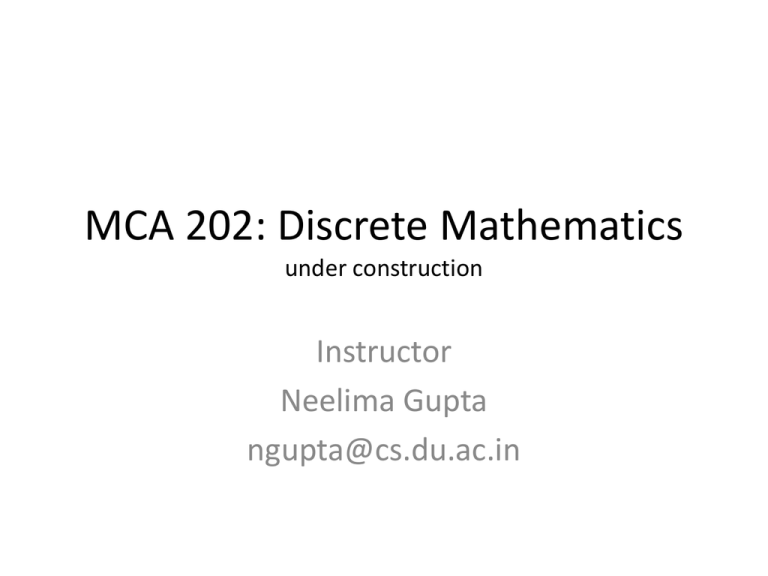Lecture 8 - EC and HC
advertisement

MCA 202: Discrete Mathematics under construction Instructor Neelima Gupta ngupta@cs.du.ac.in Table of Contents • Eulerain Path and Circuits • Hamiltonian Path and Circuits • Planar Graphs Eulerian Paths & Circuits Given an undirected graph G, a path is called an eulerian path if it spans all the vertices and scan each edge exactly once. Also, in an undirected graph G, a circuit is called an eulerian circuit if it spans all the vertices and scan each edge exactly once. Thanks: Shammi-37 and Shivangi-38 (MCA 202) Examples: Thanks: Shammi-37 and Shivangi-38 (MCA 202) Theorem: An undirected graph possesses an eulerian path iff all the vertices are of even degree except possibly for two vertices. Claim: A graph has an euler path (or circuit) if the number of odd degree vertices in the graph is two (or zero). Thanks: Shammi-37 and Shivangi-38 (MCA 202) Proving by Induction: If euler path have only 1 edge, |EP| = 1 Similarly, claim is true for (e - 1) edges, |EP| = e – 1 Now, consider a path: V1 V2 V3 V4 V5 ......... Vq Vp By removing an edge vp-vq , the claim holds for v1 to vq path. Thanks: Shammi-37 and Shivangi-38 (MCA 202) Now adding that edge vp to the initial path, the claim still follows as v1 and vp are vertices with odd degrees. Hence, proved. Thanks: Shammi-37 and Shivangi-38 (MCA 202) Converse: If the number of odd degree vertices in the graph is two (or zero), the graph has an euler path (or circuit). Start with an odd degree vertex, and we Vertices:Degrees will end with another odd vertex. V : 1, Odd V : 2, Even Hence, it has an euler path. 1 2 V1 V4 V2 V6 V5 V3 V8 V7 Thanks: Shammi-37 and Shivangi-38 (MCA 202) V3 : V4 : V5 : V6 : V4 : V4 : V7 : V8 : V2 : 2, Even 2, Even 2, Even 2, Even 3, Odd 4, Even 2, Even 2, Even 3, Odd Hamiltonian Path/ Circuit • It is a path/circuit that passes through each of the vertices in graph exactly once. • This is more constraint compare to Euler path. • There is no polynomial time solution for Hamiltonian path. Thanks: Sonam 39 and Stuti 40 (MCA 202) Hamiltonian path Thanks: Sonam 39 and Stuti 40 (MCA 202) Theorem: If in a Graph G, the sum of the degrees for each pair of vertices in G is n-1 or larger, where n is the number of vertices in the graph, then there exists a Hamiltonian path in G. Thanks: Sonam 39 and Stuti 40 (MCA 202) Figures for Proof : v1 v2 v3 vj-1 vj Thanks: Sonam 39 and Stuti 40 (MCA 202) vp vx v1 v2 vk-1 v k vj-1 vj (a) Thanks: Sonam 39 and Stuti 40 (MCA 202) vp vx v1 v2 vk-1 v k vj-1 vj (b) Thanks: Sonam 39 and Stuti 40 (MCA 202) vp Planar Graph Thanks: Sonam 39 and Stuti 40 (MCA 202) PLANAR GRAPHS •A graph is said to be planar graph if it can be drawn on a 2-D plane in such a way that no edges cross one other Example:- A D B C Thanks: Sonam 39 and Stuti 40 (MCA 202) In a planar graph, edge is only a concept of connectivity. Edge from vertex A to vertex C can also be drawn as follow:- A B A B D C D C Thanks: Sonam 39 and Stuti 40 (MCA 202) Not A Planar Graph B B A E C D A C E D There is no other way to connect edge AD and EC Thanks: Sonam 39 and Stuti 40 (MCA 202) Region : 3 A B 1 2 C D Edges belonging to : Region 1 – AC,CB,AB Region 2 – CB,CD,AB Region 3 – AB,BD,DA Region 4 – CD,DA,AC Thanks: Sonam 39 and Stuti 40 (MCA 202) 4 Theorem: For any connected planar graph, v-e+r=2 where v , e and r are the number of vertices, edges, and regions of the graph, respectively Thanks: Sonam 39 and Stuti 40 (MCA 202) Proof : By induction on number of edges. For e = 1, Number of vertices (v) = 2 Number of region(r) = 1 (outside) Putting in formula, v – e + r = 2 - 1+ 1 =2 Hence , it holds for e=1. We’ll assume it holds for graph with n-1 edges. Thanks: Sonam 39 and Stuti 40 (MCA 202) Suppose, we have connected graph G with e edges. We’ll remove one edge. CASE 1: If removing an edge leads to two disconnected graph Removed edge G’ (e2 , v2 , r2) G’’ (e1 , v1 , r1) Thanks: Sonam 39 and Stuti 40 (MCA 202) Since, Both G' and G'' have e < n-1. Therefore, using induction hypothesis, v1 – e1 + r1 = 2 and v2 – e2+ r2 = 2 Adding above two equations, v1 – e1 + r1 + v2 – e2 + r2 =2 + 2 (v1 + v2) - (e1 + e2)+ r1 + r2 = 4 v - (e -1) + r + 1 = 4(one extra region after removing one edge) v–e+r+2=4 v–e+r=2 Hence, it holds for all graph with n edges. Thanks: Sonam 39 and Stuti 40 (MCA 202) CASE 2: If removing an edge leads doesn’t lead to disconnected graph Removed edge G’ (e’ , v’ , r’) Thanks: Sonam 39 and Stuti 40 (MCA 202) Since, G’ have e < n-1. Therefore, v'– e'+ r' = 2 For graph G', v' = v e' = e -1 r' = r – 1 (subtracting region created by removed edge) v' + e' + r' =2 v–(e–1)+r–1=2 v–e+r=2 Hence, it holds for all graph with n edges. Thanks: Sonam 39 and Stuti 40 (MCA 202)










